Going on a day hike? Don’t leave home without the day hike essentials! Whether you’re a hiking novice or a seasoned trekker, knowing what to pack for day hiking gear is key to a successful and enjoyable adventure.
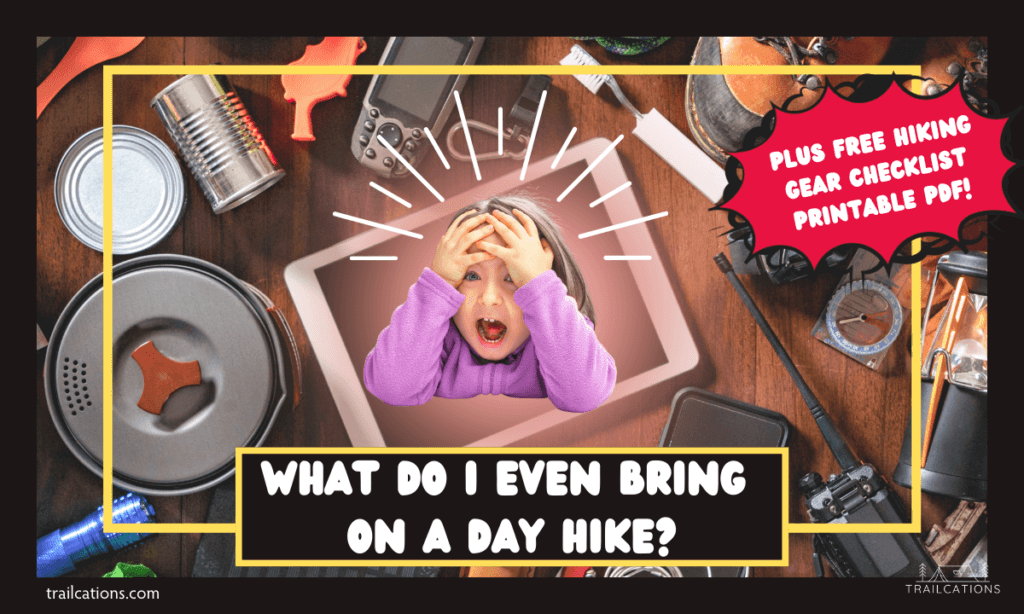
Key Takeaways
Day hike essentials include the important gear you should bring on your hike to have a safe and enjoyable outdoor trip. If you don’t have time to read the entire article, check out the Trailcations Free Printable PDF of Day Hike Essentials to pack with you.
Table of Contents
Why is a Day Hike Essentials Checklist Important?
When I’m preparing to go on a day hike, there’s so many items to pack that I always worry about what gear I’m going to forget.
I hate being on a day hike and finding out I packed too little food and then I get hangry. Worse is when I forgot my rain jacket at home and it started pouring – I almost got hypothermia and had to run down the mountain to stay warm.
By the time I reached the parking lot, I was so exhausted and didn’t realize I also looked like a drowned dirty Bigfoot.
A family of hikers in the parking lot took one look at me, exchanged glances and quickly shoved their kids into their car. They drove off so fast in their minivan that they left tire tracks on the pavement.
Besides scaring an innocent family, I shivered the whole way home and my car smelled like a wet hiker for days!
Pro Tip: Gear Checklists are a Day Hike Essential
Don’t get caught unprepared on your day hike! Download our free printable PDF of day hike essentials and read on about what gear you should bring on a day hike.
From must-have gear like navigation tools and illumination to the perfect trail-friendly snacks, we’ve got you covered. Join us as we explore the essential items that will ensure you’re prepared for whatever the trail may bring.
Get ready to pack smarter, hike happier, and make the most of your outdoor experience!
Understanding Day Hike Essentials
Before you start packing, it’s important to understand what day hiking is and what it entails. Day hiking is a popular activity that involves hiking on a trail or path for a few hours or a full day.
Unlike backpacking, day hiking does not involve camping overnight on the trail. Day hikes can range from easy to difficult, an hour to all day and the terrain can vary from flat to steep and rocky. Day Hike Essentials Rule #1: It’s important to choose a trail that matches your skill level and experience.
Overall, day hiking is a fun and rewarding activity that can be enjoyed by people of all ages and fitness levels. By understanding day hike essentials like how to plan for a day hike and what gear you will need to pack, you can ensure that your hiking trip is safe and enjoyable.
Want to learn more about day hiking and how to avoid common mistakes many beginner day hikers make? Check out Introduction to Day Hiking: Tips and Tricks (and What NOT to Do).
Pro Tip: Day Hike Essentials Rule #1: Don’t overestimate your abilities! Choose a hiking trail that matches your skill level and experience.
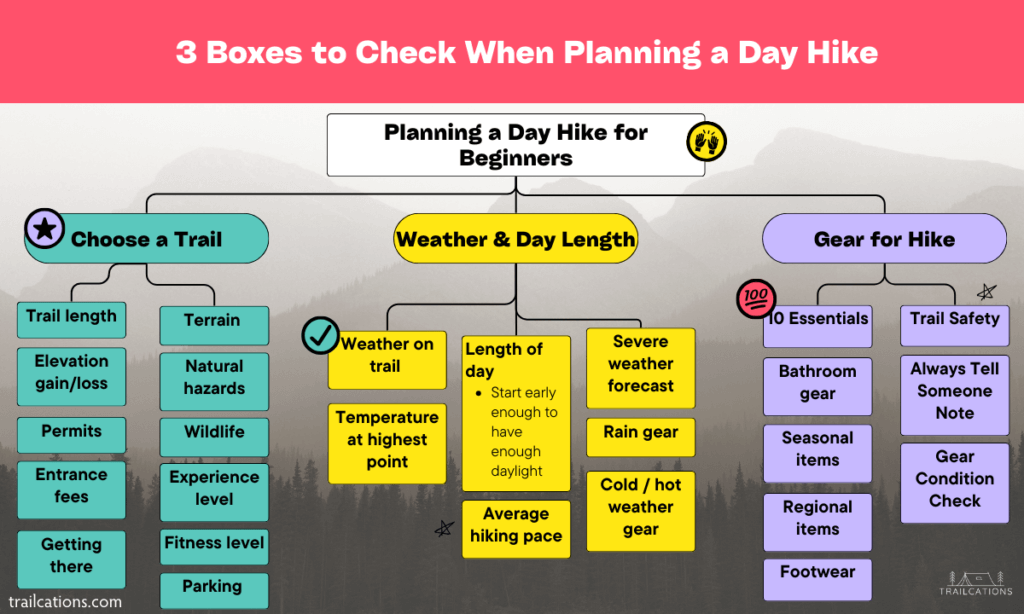
How to Prepare for a Day Hike: 3 Steps
To prepare for a day hike, there are several important steps to take before hitting the trail.
1. Choose a Trail:
First, keep in mind factors like your fitness level, experience and how long you want to be hiking for when choosing a day hike. Plan out how you’re going to get to the trail, what permits or entrance fees you’ll need and any wildlife or natural hazards you’ll have to be prepared to encounter.
2. Weather & Day Length:
Additionally, it’s crucial to stay informed about the weather and pack and prepare for any potential changes. Steep terrain or bad weather will cause you to go slower and rugged areas might not be appropriate for all hikers. Keep in mind day length, giving yourself enough time to complete the hike including rest breaks and the average hiking pace of the slowest member of the group.
3. Gear for Hike:
When asking yourself what to pack for a day hike, use a checklist to make sure you have all of your day hike essentials. Before leaving, ensure all your gear is in good working condition and medications aren’t expired. This includes checking your navigation tools, illumination, hydration, food, first aid kit and other essential equipment.
How to Keep Track of All Your Gear When Packing for a Day Hike
- Pack From Memory (The Leeroy Jenkins Method aka just go for it)
- Use a Gear Checklist (like our super awesome possum free PDF)
- Track Your Gear Online Using a Lighterpack List
Pro Tip: There are 3 ways you can check to make sure you have all of your day hike essentials gear. Some work better than others!
4. Bonus Step:
Finally, it’s important to rest, eat well and hydrate the day before the hike to ensure you’re in prime condition for the adventure. A little remembered part of day hike essentials is to make sure your body is prepared for your adventure.
By taking these steps, you’ll be well-prepared to enjoy a safe and fulfilling day hike.
What Should a Beginner Bring for Day Hiking?
Day hiking is a great way to enjoy the outdoors, get some exercise and explore new trails. However, it is important to be prepared for your hike to ensure a safe and enjoyable experience.
The most important day hike essentials to bring with you is water and some common sense – you’ll be surprised how far this will get you on the trail!
In addition, it’s helpful to use a hiking packing list to remember all of the essential gear to have the best hiking experience possible. Check out our Trailcations Free Day Hike Packing List Printable PDF to help make your hiking preparation a little easier.
Basic Day Hike Essentials
When it comes to packing for a day hike, there are a few essential items that you should always have with you. These include a backpack, weather-appropriate clothing, hiking footwear, plenty of food and water, navigation tools such as a map and compass, and a first-aid kit. It’s also a good idea to pack sunscreen, insect repellent, and a headlamp or flashlight in case you end up hiking longer than expected. With the right gear, you can stay comfortable and safe on your day hike.
In detail, here are some of the most important items you should pack for your next day hike.
The 10 Essentials: What to Bring on a Day Hike
Even if you’ll be gone only for an hour or two, there’s a few day hike essentials that every hiker should bring with them in a small backpack or bag. In hiker lingo, these items are often referred to as “The 10 Essentials,” or the 10 systems of day hike essentials.
What are the 10 Essentials for Hiking?
The 10 Essentials are the basic items you should have with you on any outdoor trip for first aid or in case of an emergency. This can include minor injuries, abrupt weather changes or unexpected delays.
Keep in mind that these essentials are only the basic items you should bring with you. You ‘ll likely need additional gear depending on the season, type of outdoor activity and location (ex: micro spikes, bear spray, insect head net). Always visit your park or region’s website to learn more about the area before heading out. Day hike essentials vary from region to region.
Pro Tip: Even if you have all the right gear, things can still go wrong in the backcountry if you don’t know how to use the item. Many hikers assume that because they bought the latest and greatest gear that they’ll be safe. However, if you don’t know basic wilderness survival skills like how to start a fire or what the signs of hypothermia are, you can quickly find yourself in trouble on a hike.
Here are the 10 Essential Items to bring on your day hike:

1. Navigation Tools – Map, Compass, GPS
- Paper map (preferably waterproof paper)
- Compass (know how to use it!)
- GPS unit (fully charged)
- Navigation Apps (downloaded for airplane mode) on smartphone (fully charged)
- Power bank for GPS/smartphone + necessary cables
Navigation tools are not only used for planning your route before your hiking trip but also help you stay on the trail and find your way back to your starting point.
Day Hike Essentials: Don’t Just Have the Gear – Know How to Use it!
Having a compass and map is a good start but you can run into trouble if you don’t know how to actually use a compass or read a topographic or relief map.
It’s important to adjust the magnetic declination of your compass before hiking somewhere new since magnetic north and true north vary by geographic location and year-to-year. I had forgotten about this from middle school geography class and got wildly lost when I first started hiking and orienteering.
In today’s world, it’s also helpful to have a GPS device or use some of the free or subscription smartphone apps for hiking, navigating and GPS. Make sure your smartphone and GPS are 100% charged before leaving for your hike!
Pro Tip: Smartphone and GPS batteries eventually die or can malfunction in the backcountry. Always make sure you have a paper map as a back up! (A back up battery or power bank might not be a bad idea either.)
Pro Tip: Cell service can be sparse or non-existent on a hike, quickly draining your phone’s battery as it tries to find signal. Turn your phone to airplane mode on the trail and in low power mode to save battery life.

Best Trail Navigation Apps for Smartphones
In no particular order, some of my favorite offline trail navigation apps for my smartphone are:
- Garmin Explore (you don’t need a Garmin device to use this)
- Gaia GPS
- Strava
- FarOut (for certain trails only)
- AllTrails (offline trail uses is a premium feature)
- Komoot
- NPS App (US National Parks and Monuments only)
- Avenza Maps
- Google Maps (not the best for offline trails but good for driving in remote areas)
Pro Tip: Don’t forget to download the offline versions of your navigation apps at home before setting out on your hike! Always check a park’s website or social media for latest conditions before heading out.
Some of these navigation apps may only work for certain regions or have offline maps as a premium feature. Always make sure to download your navigation maps before leaving for your hike!

2. First Aid Kit – Bandages, Medications, Antiseptic, etc.
At a minimum, a First Aid Kit should contain:
- Bandages (large, medium and small)
- Antiseptic wipes and/or antibiotic cream
- Blister bandaids and/or moleskin
- Pain reliever medications
- Antihistamines (ex: Benadryl)
- Personal medications (bring an extra day’s worth in case of emergency)
- EpiPen if anyone in your group has life-threatening allergies
Additional First Aid Kit Items (Optional But Useful)
- Anti-diarrheal medication (ex: Imodium or Loperamide)
- Anti-emetic medication (ex: Dramamine)
- Antacid medication (ex: Pepto Bismol)
- Salt tablets for cramping prevention (ex: Endurolytes)
- Leukotape or athletic tape for wrapping ankles, blister prevention
- ACE bandage
- Anti-chafe cream
- Gauze packets
- Disposable Nitrile gloves (avoid latex bc many people have allergies)
- Triangular bandage
- Tourniquet
- First aid pamphlet (ex: NOLS Wilderness First Aid)
- Personal Locator Beacon or Satellite Phone
A first aid kit is a must-have item for any hiking trip. It should include items such as bandages, antiseptic wipes, pain relievers, blister prevention aids, personal medications, etc. First aid kits for day hiking can be as simple as buying a pre-made kit for beginners and then modifying to fit your needs.
Know How to Use the Items in Your First Aid Kit
It is important to know how to use the items in your first-aid kit before you start your hike. Check the expiration date on all the items and replace them before going out on a trip. Some expired medications can become less effective over time or cause bad side effects.
If you become really passionate about hiking, consider signing up for a Wilderness First Aid course near you to learn more about backcountry medicine and how to treat someone who is injured in the wilderness.
Pro Tip: Consider carrying a Personal Locator Beacon (PLB) or satellite phone in case of emergencies as part of your day hike essentials. Most PLBs weigh a few ounces/grams and can also help with GPS navigation, communicating with authorities in emergencies, letting loved ones back home know where you are and finding local weather conditions, all without cell service. Pretty nifty !

3. Sun Protection – Sunglasses, Hats, Sunscreen, Sun Protection Clothing
- Sunscreen
- Sunglasses (UVA/UVB Protection, Polarized if near water or in snow)
- Sun hat, ball cap, hiking hijab or sun hoodie
- Long sleevelightweight sun shirt (SPF rated ideally)
- Long lightweight hiking pants
Sun protection is so important to protect your skin and eyes against cancer-causing UV rays and prevent dehydration. Especially high up in the mountains, hiking on the snow, in the desert or during summer, the sun can cause you to quickly become sunburnt, dehydrated, snow-blind or worse.
Always use sunglasses, sunscreen, hats and sun protection clothing such as lightweight pants and long sleeve sun shirts. Leave the wrinkles and sunspots for the noobs!

4. Hydration – Water, Water Purification
- 1 liter of water per 2 hours (may be more depending on medications, altitude, activity intensity, hot weather)
- Hydration water bladder and/or water bottles (ex: Smartwater bottles, gatorade bottles filled with water, Nalgenes, hydroflask)
- Water purification method (backcountry water filters, water treatment chemicals, UV purifiers)
- Electrolytes drink mix, sports drink and/or salt tablets
How Much Water to Bring on a Day Hike?
The amount of water to bring on a day hike can vary depending on factors such as the individual’s needs, weather conditions and the availability of water sources along the trail. A general recommendation is to bring about 2 cups (about 0.5 liter) of water for every 1 hour of hiking for adults, and 1-2 cups of water for every hour of hiking for children.
Day hike essentials like a portable water purifier give you the ability to filter water along the trail. Depending on the environment and recent rainfall, if there are reliable water sources on the trail, you may be able to carry less water and refill as needed.
It’s always best to err on the side of caution and bring more water than you think you’ll need for the hike, especially in hot or humid conditions. Pre-hydrating before the hike and drinking regularly during the hike are also important for maintaining proper hydration.
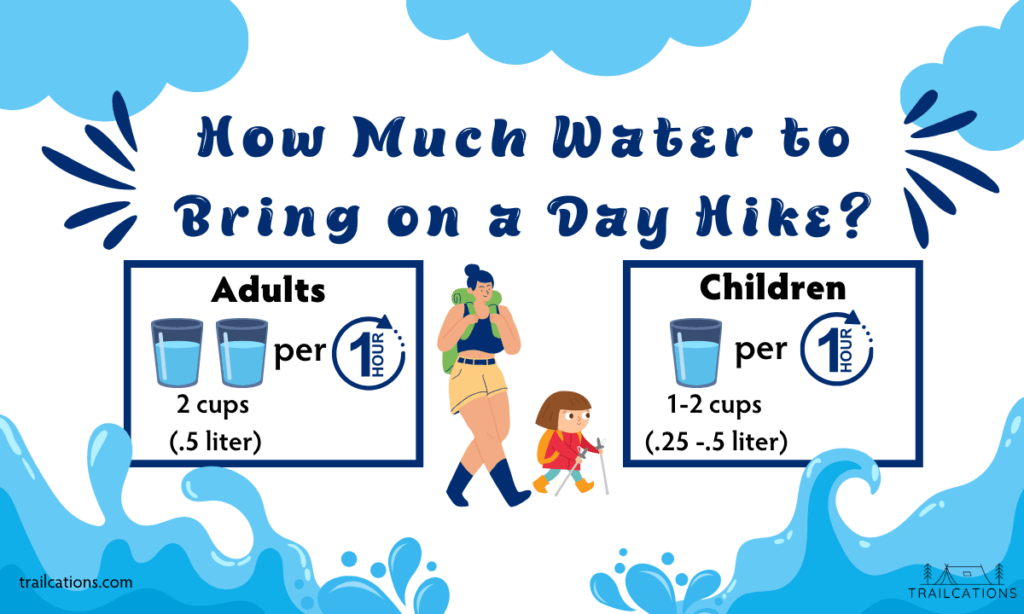
Sweating = Water + Salt Loss
Staying hydrated is of #1 importance during a hike, so it is important to bring enough water for the duration of your hike, or a means to purify it from the backcountry. Physical activity increases the risk of dehydration (losing salts and water from the body) which can lead to heat exhaustion, heat stroke and worse.
Consequently, drinking too much water can also cause problems so make sure you pack some sports drinks, salt tablets or electrolyte drink mixes to balance you out and avoid muscle cramps. Part of my day hike essentials in my first aid kit are salt tablets which are a lifesaver on the trail when you start getting muscle twinges and cramps.
Pro Tip: In addition to bringing enough water, pack some salty snacks (ex: pretzels, chips, jerky) and electrolyte drink mixes or salt tablets/pills. Sweating and drinking lots of water can lead to cramping if you lose too much salt. Chow down on some salty snacks or pause to make (and drink!) an electrolyte drink. On really hot days or on long, arduous hikes, we’ll take a salt pill every few hours.
Drink Before You’re Thirsty
Some outdoor enthusiasts encourage you to drink at least one liter of water for every two hours of hiking. However, you should always drink before you get thirsty, especially in hot weather. Rather than chugging water infrequently, take frequent sips to stay hydrated. Set a timer for every 20 minutes if you forget!
Make Water Easily Accessible
A hydration bladder with a hose attached to your pack strap is much easier to access your drinking water and stay hydrated, compared to having to stop to pull out a heavy Nalgene bottle from the bottom or side of your pack. Hydration bladders are part of my day hike essentials since they come in various sizes. I honestly can’t remember the last time I left the house for a day hike without my hydration bladder!
Always Purify Water in the Backcountry
Before you’re heading out on your trip, identify any bodies of water on/near the trail that you could reliably collect and purify water. Never drink untreated water unless it is a true emergency as microscopic bacteria, viruses and parasites can cause immediate and long lasting waterborne illnesses.
Pro Tip: Some medications or medical conditions can make you thirstier than normal. Personally I drink about 1 liter of water for every 3 miles (5km) or 1 hour of hiking but I also am on medication (Fluoxetine) that makes me thirsty.

5. Nutrition – Snacks, Meals, Extra Food
- High calorie snacks – granola bars, trail mix, dried fruit, jerky, cookies, nut butters, desserts
- Salty snacks – chips, pretzels, seaweed snacks, cheese, crackers
- Electrolyte drink mixes, sports drinks
- Meals – sandwiches, wraps, bagels, tuna/plant meat packets, pasta salad, no cook soup/noodles
- Trash bag for wrappers
- Optional: Ultralight spork or disposable utensils
Always be prepared for possibility of changes to your trip plans and bring more food than you think is necessary. Generally you should pack about 200 to 300 calories for every hour of hiking, plus an extra day’s worth of food for longer hikes.
What Snacks to Bring on a Day Hike?
For short day hikes, pack high calorie, easily digestible snacks such as trail mix, granola bars, cookies, dried or fresh fruit, jerky and salty snacks. Even if you’re just going for a short hike, throw in a couple of granola bars and salty snacks to keep your energy levels high and avoid cramping.
What Food to Bring for a Long Day Hike?
Supplement longer day hikes with portable meals or lunches such as sandwiches, cheese and crackers, pasta salad, hardboiled eggs, meats in packets or shelf stable foods to help keep you fueled during your hike.
Pack It In, Pack It Out. Leave No Trace (LNT) Principles for Nutrition
Don’t forget to pack out all of your food trash! Part of your LNT day hike essentials should be a ziploc bag to dispose of all of your micro-trash wrappers, food scraps and containers to throw out when you return to civilization.
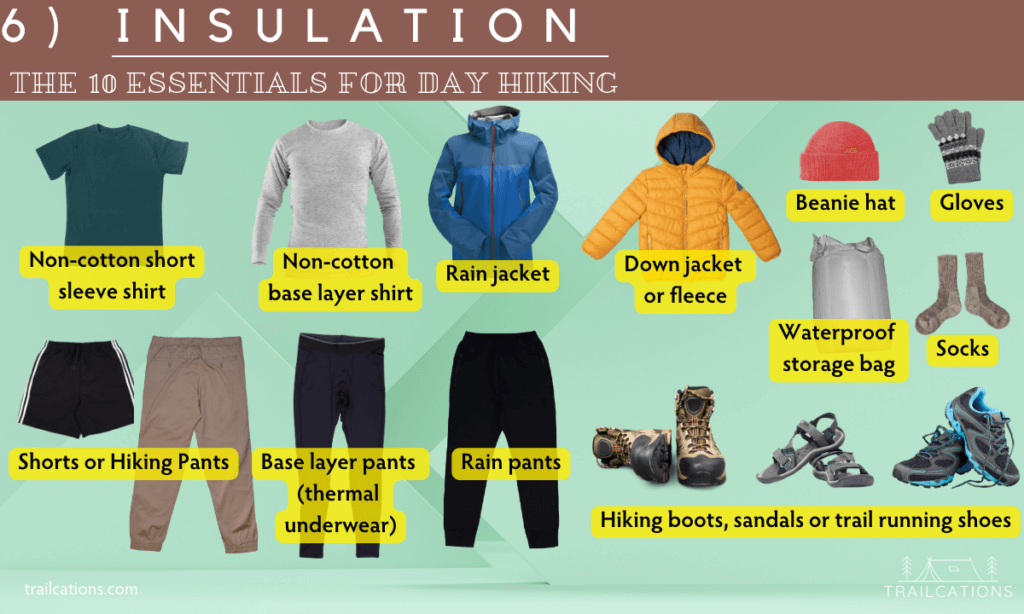
6. Insulation – Jacket, Hat, Gloves, Rain Shell, Thermal Underwear and Footwear
- Shortsleeve or t-shirt base layer
- Longsleeve base layer
- Leggings or thermal underwear base layer
- Hiking shorts or pants
- Rain jacket or poncho
- Rain pants or rain skirt
- Puffy jacket (down, synthetic)
- Warm hat or beanie
- Gloves
- Socks – wool, toe or anti-friction socks
- Sturdy hiking boots, sneakers or sandals with good tread on the bottom
- Waterproof storage bag for keeping clothes dry
- Optional: Neck gaiter
- Optional: Shoe gaiters to keep out debris
- Optional: Sandals, crocs or water shoes for water crossings
Wearing appropriate clothing and footwear is important for a comfortable and safe hiking experience. Dress in layers so you can adjust to changing weather conditions. Finally, wear sturdy hiking boots or shoes with good traction to prevent slips and falls.
Nature is unpredictable and the weather can change in an instant. It might seem like overkill but always pack extra clothing that reflects the most extreme weather conditions you may encounter (ex: rain jacket in the desert).
Hypothermia can set in quickly even during a warm spring day, especially if it starts raining or if it’s windy.
Pro Tip: Pack your extra clothing in a waterproof bag, large ziploc bag or contractor trash bag to keep it dry in case of storms. Dry clothing saves lives.
Pro Tip: Cotton kills! Avoid hiking in cotton clothing, especially shirts and pants, as cotton doesn’t dry fast after getting wet from sweat or rain. You can quickly become hypothermic wearing cotton or cotton-blend clothing. Opt for wicking fabrics like wool, nylon, polyester or bamboo.

7. Emergency Survival Gear – Emergency Shelter, Whistle, Signaling Instrument
- Emergency shelter: space blanket, ultralight tent, bivouac or tarp
- Whistle
- Signaling mirror
- Optional: Personal Locator Beacon or Satellite Phone
- Optional: Portable saw, 550 paracord, the list goes on and on
Exposure to the elements and severe weather can kill you only in a few hours. Consequently, having a lightweight emergency shelter like a space blanket, tarp, bivouac (bivy) or tent is one of the most important day hike essentials to have in an emergency survival situation.
Hopefully you’ll never have to use this category of gear. However, nature is unpredictable, injuries can happen or delays can cause you to be outside longer than anticipated.
Besides packing a lightweight emergency shelter, bring a lightweight whistle or whistle buckle to call for help and a signaling instrument such as a small reflective mirror to signal to a pilot in case of airplane rescue.

8. Gear Repair – Duct tape, Lightweight Knife, Screwdriver, Scissors, Sewing Kit
- Duct tape
- Pocket knife of small multi tool (screwdriver, knife, scissors, pliers)
- Sewing kit (large canvas sail needle for pack repairs, small needles, thread, floss, safety pins (large ones are best))
- Super glue
Tiny but mighty, a gear repair kit is part of the day hike essentials that can help you with fixing hiking equipment on the fly in the backcountry. In our experience, duct tape, super glue and a small lightweight multi-tool can fix most everything on trail, from loose hiking poles to repairing boots or torn packs.
Honestly, 99% of the time I use my lightweight knife for cutting delicious cheese snacks. 🙂 Our tiny sewing kit mostly gets used on longer hikes for torn packs, holey socks or ripped clothing when we’re spending a few nights out in the wild.
Pro Tip: Don’t bring a whole roll of duct tape with you! Instead, wrap a long length of duct tape near the top of your hiking poles (on the pole itself, not the handle).
Pro Tip: A tiny multi tool with pliers can be especially helpful on desert hikes, especially when you’re not paying attention and accidentally back up into a cactus. Pliers are perfect tools for removing sharp cactus spines from, uh, sensitive areas. Don’t ask us how we know this. 🤦♀️

9. Fire – Lighter, Matches, Fire Starters
- Choose Two:
- Fire starter tool
- Waterproof matches
- Lighter
- Optional: Fire starting materials in a container/bag: dryer lint, vaseline-soaked cotton balls, wood shavings
The ability to start a fire is important in case of emergencies when you need to stay warm or cook/boil water if you are delayed from returning from your hike. Always have two methods to light a fire in case one fails (ex: matches get wet, lighter breaks).
Pack preferably waterproof matches and fire starters (items that catch fire quickly and can hold a flame) like lighters or small titanium fire striker tools. However, some places are so dry that a small flame can quickly grow out of control so check for local fire bans or warnings before heading out.

10. Lighting – Headlamp, Flashlight or Lantern, Extra Batteries
- Headlamp, Small Flashlight or Lantern
- Extra batteries or battery pack with charging cable (for rechargeable headlamps)
- Backup lighting method
Lighting is so important in the backcountry, especially if you accidentally overestimate your hiking abilities and the roughness of the trail. Especially when I first started hiking, I was caught out hiking after dark more than once and it would’ve been a very bad situation if I hadn’t packed out a lightweight headlamp.
Sometimes the moon can be very bright but don’t count on it for navigating, avoiding trip hazards or accidentally walking into wildlife. Instead, pack a lightweight flashlight, lantern or headlamp with extra batteries as part of your day hike essentials.
Headlamps are the preferred light source for hiking because they’re hands-free, ultralight and can be found for relatively cheaply online or in sporting goods stores.
Pro Tip: Most smartphones have a flashlight app but it can be very hard to navigate with this in the dark. Don’t rely on smartphones to guide you back to the car after sunset. Instead, pack out an ultralight headlamp for hands-free nighttime navigation.
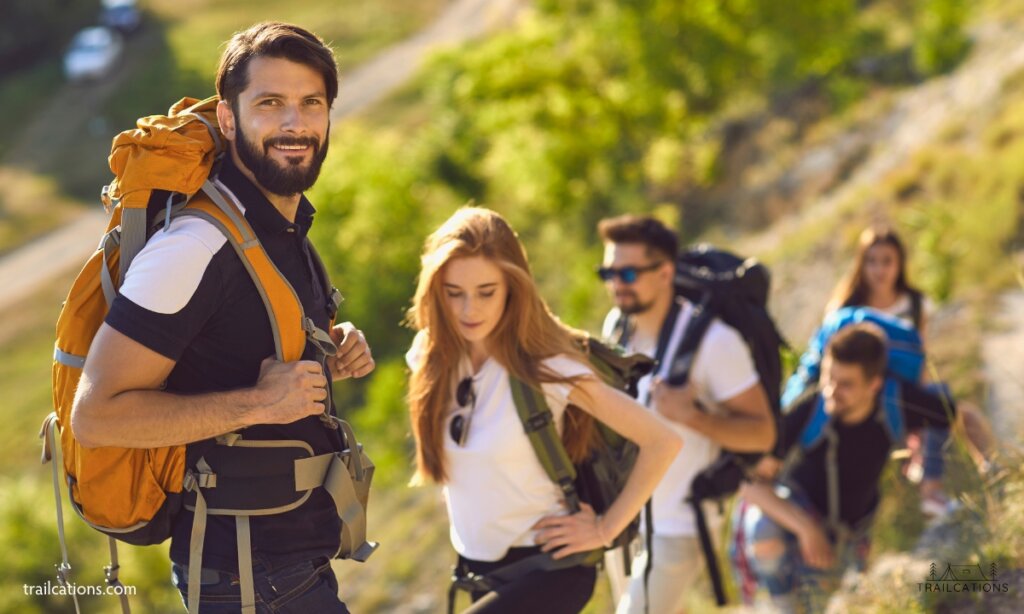
Other Gear Essentials for Beginner Day Hikers
The 10 Essentials are a good start for surviving a day hike as a beginner hiker. However, some other day hike essentials to bring on your adventure include a backpack to carry all of your gear, bathroom hygiene items, seasonal items and regional-specific items.
Backpacks for Day Hiking
Backpacks, bags, hydration packs or fanny packs (waist or bum bags) are important to keep all your gear stowed away so it doesn’t get lost while you’re hiking. You want the bag to be comfortable while hiking for a few hours and also allow you to be hands-free in rough terrain, so avoid purses or beach bags.
In my experience, if you don’t have a seam-sealed, waterproof backpack, the next best of the day hike essentials to keep your gear dry is a waterproof pack liner. This could be something like a trimmed down contractor trash bag works to keep all of your gear dry in a storm. Some people prefer pack covers which I’ve seen blown away or leak. To each their own – hike your own hike!
Best types of bags for day hiking
- 20-30 L backpack
- Small daypack
- Sling bag
- Hydration pack or hydration vest
- Fanny pack or bum bag
- Waterproof pack cover or DIY contractor trash bag liner for your pack
Check out this table to find out how big a hiking pack you’ll need for day hiking:
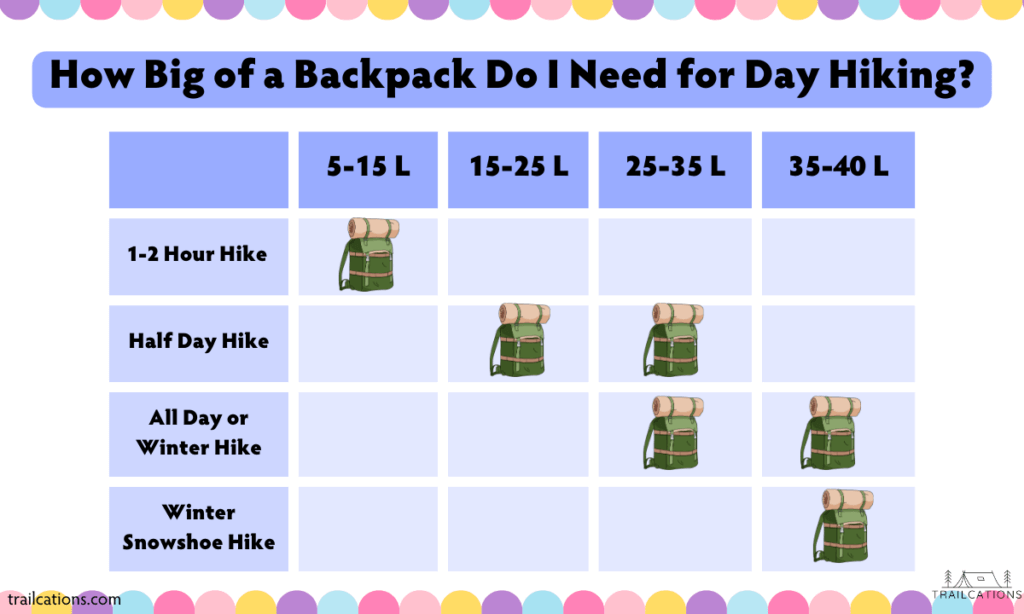
How big of a pack do I need for day hiking?
The size of your day hiking pack will vary depending on the season, how long you’re going hiking for and how much gear you’re carrying. Generally a 20-30 liter backpack is the perfect size for day hiking.
If you’re just starting out hiking and are on a budget, you might have heavier gear than someone who has been hiking a long time. In that case, you may find yourself with a bigger sized day pack closer to 40 liters in order to fit all of your day hike essentials gear.
Packing Your Backpack
When packing your backpack, organize your gear into compartments to make it easier to find what you need. Use a packing list or hiking checklist to make sure you don’t forget anything important.
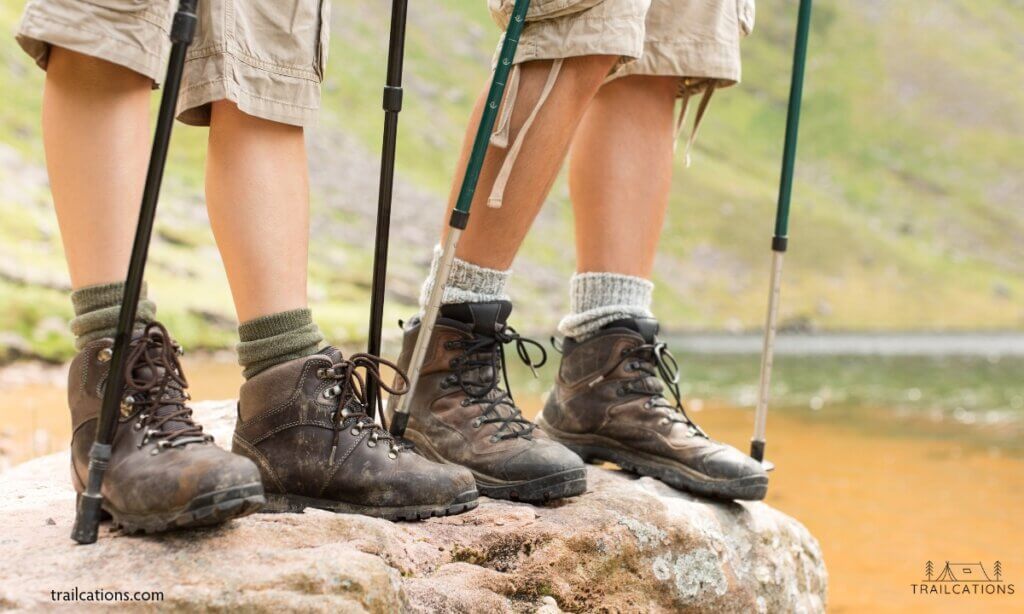
Bathroom Hygiene Items: Don’t Forget These Day Hike Essentials
When nature calls while you’re hiking, you don’t want to be left without the necessary hygiene tools.
I can’t tell you how many trails I have been on where I would see discarded socks and underwear in the woods because people forgot to pack toilet paper! Ew. 🫠
Don’t hike back to the car commando because you forgot to toss in some TP (and a plastic bag for garbage). The “missing sock hiker” is not a good look!
Backcountry Bathroom Items for Day Hiking
- Toilet paper (no need for a whole roll – just roll up a length of it)
- Plastic bag to keep your toilet paper dry if it rains
- Plastic ziploc bag for used toilet paper, pads, tampon trash
- Small container of Castile soap or hand sanitizer
- Poo trowel for digging 6-8″ deep cat hole for #2
- Optional: Baby wipes
- Optional: Backcountry bidet attachment for water bottle
- Optional for women: Kula pee cloth or handkerchief for #1, period supplies if it’s that time of month, female urinal device if you’re so inclined (ex: Shewee)
Pro Tip: For discreet bathroom trash disposal in the wilderness, place a ziploc style bag inside an opaque plastic grocery bag. The ziploc bag will keep the toilet paper scent in and the plastic grocery bag provides visual discretion. Even though everyone goes to the bathroom, no one wants to be hiking behind you looking at and smelling your dirty toilet paper!
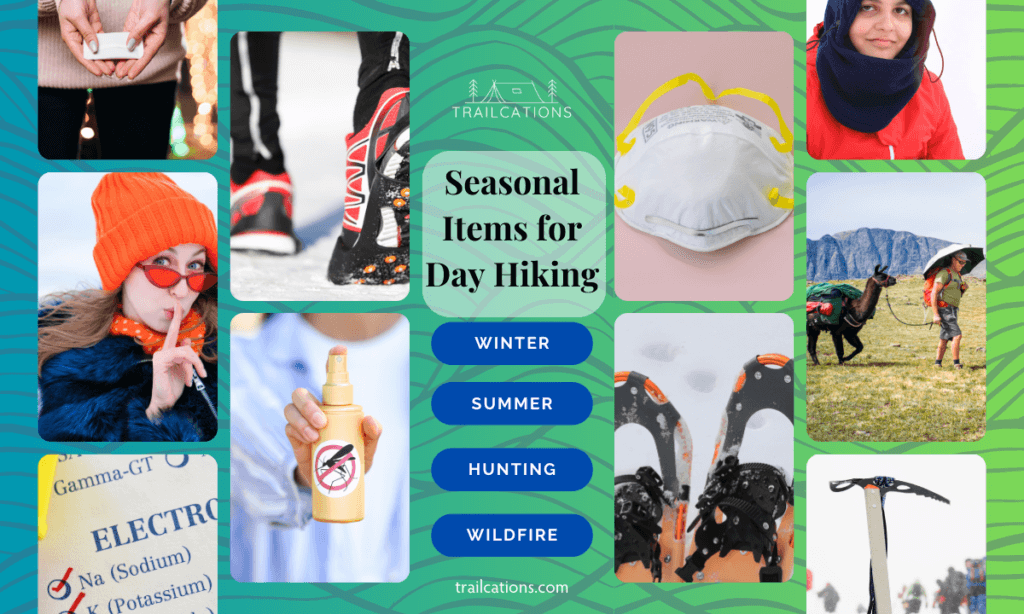
Seasonal Items for Day Hiking
Seasonal items could include an extra jacket, fleece, bright orange clothing for hunting season, neck gaiter or scarf, snowshoes, micro-spikes, bug spray, bug head nets or a sun umbrella.
Depending on weather conditions, you may also have to bring some of these seasonal items with you while hiking in the shoulder seasons like spring or fall.
Summer Seasonal Items for Day Hiking
- Bug spray
- Insect net for head or full body insect suit
- Sun hoodie shirt or neck gaiter to protect from sunburns
- Extra electrolytes to replenish sweating
- Sun umbrella
- Sun gloves
Winter Seasonal Items for Day Hiking
- Extra layers or jacket
- Fleece pullover
- Warm neck gaiter or scarf
- Snowshoes
- Micro-spikes
- Ice axe (depending how steep and snowy the terrain is)
- Waterproof gaiters or snow pants
- Hand or foot warmers
Hiking During Hunting Season Items
- Bright orange hat
- Bright orange vest, jacket, shirt (may have to be a minimum size – check local regulations)
Hiking During Wildfire Season Items
- N95 or KN95 mask (or maybe just stay home lol)
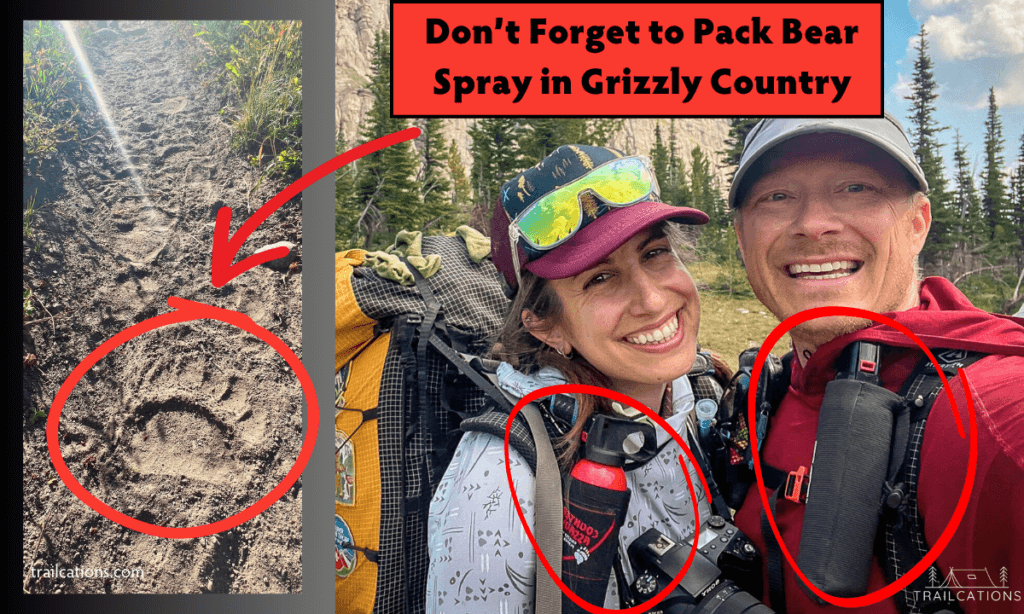
Region-Specific Day Hike Essentials
Some regions might have food storage requirements like a bear canister or be home to dangerous animals like venomous snakes (pack knee-high gaiters) or grizzly bears (bring bear spray and have it easily accessible).
In dry, desert environments, there might not be enough rain to decompose toilet paper or human waste so you might have to pack your #2 out in a kitty litter-filled “WAG bag” – yep that’s a thing!
Region-Specific Items Examples
- Problem bear country: Bear canister for food storage
- Grizzly bear country: Bear spray (have this easily accessible where you can have it hand in under 3 seconds)
- Desert or canyon hiking: Human waste bags or WAG bags
- Cactus country: Tweezers or pliers for removing cactus spines
- Tick country: Tweezers to remove attached ticks
- Tick, chigger and mosquito country: Permethrin sprayed on gear before your hike
- Snake country: Tall boots and/or thick knee-high gaiters to protect from bites
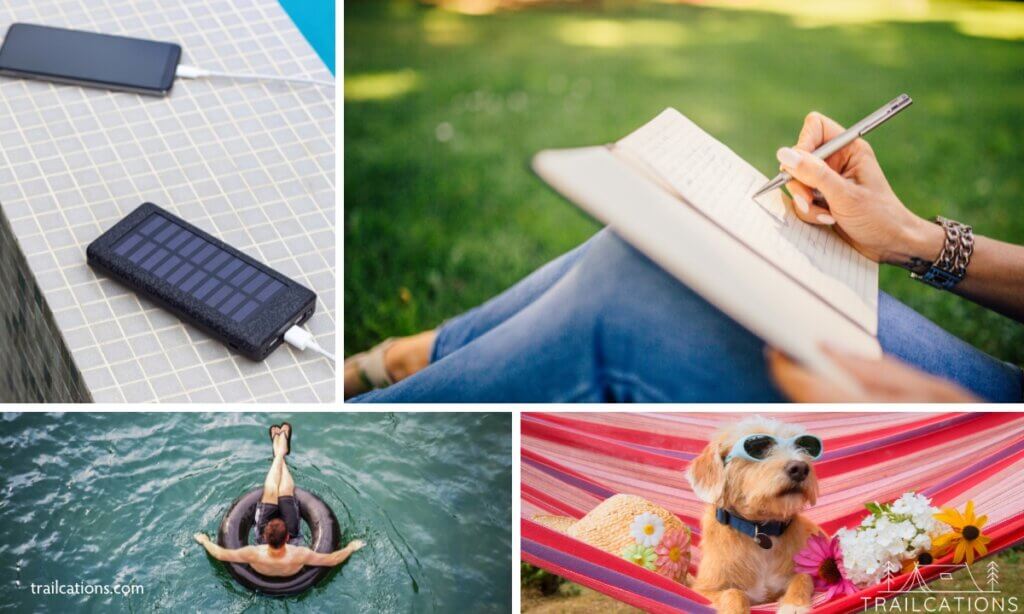
“Luxury” Items for Day Hiking
In hiker lingo, “luxury items” are gear that isn’t necessary for your hike but may help you better enjoy your outdoor adventure. It could be something as small as a hiking journal to a heavy photography camera set up.
Luxury items aren’t usually necessary for a hike but are brought along for people to enjoy their hiking experience better. Think ultralight and don’t pack too much.
Keep in mind that the heavier your pack is, the slower you’ll hike and more risk for injury.
Optional Luxury Item Ideas for Day Hiking
- Ultralight chair or foam sit pad
- Ultralight hammock for relaxing
- Trekking poles (the more I hike, the more I love these!)
- DSLR camera, tripod, lenses
- Journal and pen
- Book, Tablet/e-Reader
- Extra clothing
- Sports equipment – football, softball, frisbee
- Alcohol
- Coffee
- Bluetooth speaker (*sigh* – blaring music in the backcountry is the bane of many hikers’ existence)
- Solar charger
- Blow up raft or tube for floating
- Kite
- Picnic blanket or tarp
- Games – cards, dice, lightweight chess set
- Instrument – lightweight guitar, fiddle, harmonica
- Battery-powered fan
By bringing these essential (and maybe not-so-essential) items on your day hike, you’ll be sure to have a safer and more enjoyable experience on the trails.
Before You Set Out
Before you set out on your day hike, make sure you have everything you need and that you’re prepared for the terrain and weather conditions.
Apply insect repellent and bring any necessary medication.
Check the weather forecast and plan accordingly.
Leave a copy of your itinerary and when you should be expected back with someone reliable.
With the right gear and preparation, you can enjoy a safe and memorable day hike.
What Should I Wear on a Hiking Day? Best Clothing for Day Hikes
When going for a day hike, it’s important to wear clothing that is comfortable, flexible and provides protection from the weather, plants and insects. Here are some recommendations on what to wear while day hiking:
What Types of Fabrics Should I Wear on a Day Hike?
– Moisture-wicking activewear: Choose clothing that is moisture-wicking, such as what you would wear to the gym or on a run. This includes comfortable, flexible, and protective clothing that can also guard against spiky or poisonous plants and bugs.
– Avoid cotton: It’s not recommended to wear cotton clothing for hiking, as it retains moisture and can cause hypothermia. Instead, opt for moisture-wicking, quick-drying fabrics like wool or synthetic materials.
What Type of Footwear Should I Wear for Day Hiking?
– Hiking shoes, sandals or boots: Opt for sturdy footwear that provides support, protection from rocks and roots and traction on wet and dry surfaces. Heavy-duty or leather hiking boots are not necessary, but the footwear should be suitable for the terrain.
Trail running shoes are very popular for day hiking due to their lightweight, quick-drying properties. Hiking sandals are another popular minimalist option for hiking footwear.
– Hiking socks: It’s also important to wear high-quality socks that are quick drying and anti-chafing to avoid blisters. Popular options for hiking socks are wool socks or synthetic materials. Toe socks are excellent for extra blister protection.
What Type of Clothing Should I Wear for Day Hiking?
– Layered clothing: Wear light layers against your body and carry extra warm layers in your backpack in case temperatures fluctuate during the hike. For example, in cold conditions, baselayers are recommended, and in wet or cold hikes, it’s advisable to have an extra pair of dry socks.
– Sun protection: Consider wearing a long sleeve sun shirt, lightweight pants, hat and sunglasses for sun protection, especially in warm weather. Wearing sun protective clothing means you have to use less sunscreen which saves you money and pack weight.
– Hiking pants, leggings or shorts: Choose hiking pants, leggings or shorts based on the weather and your personal preference.
When dressing for a day hike, prioritize comfort, flexibility and protection from the elements.
Choose moisture-wicking, quick-drying fabrics and avoid wearing cotton at all costs! Additionally, select appropriate footwear for the terrain and consider layering your clothing to be prepared for changing weather conditions.
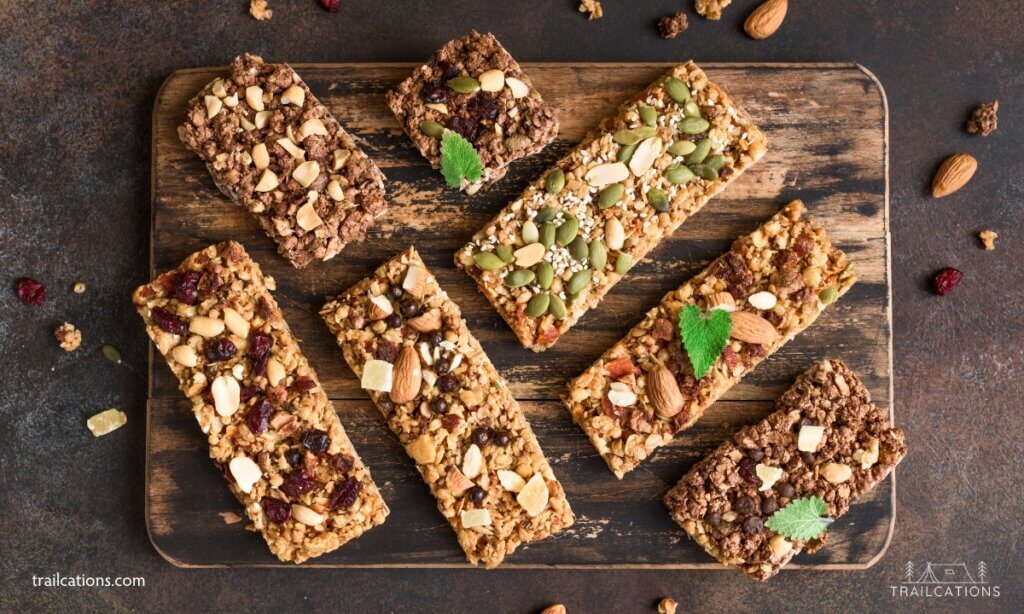
What Food to Bring on a Day Hike?
When planning food for a day hike, it’s important to consider options that are convenient, nutritious and provide sustained energy. There are a variety of options for day hiking food that are healthy and taste good.
Some of my favorite foods to bring on a day hike are:
Snacks to Prevent Hangry Hikers
1. Trail mix: A combination of nuts, dried fruits, chocolate and whatever else you want to add provide a high calorie convenient snack. Trail mixes with almonds, cashews, and other nuts are high in fat and provide long-lasting energy for your whole hike.
2. Jerky: Beef, turkey, plant-based meat or mushroom jerky provides a delicious chewy treat with lots of protein and replenishing salt for a sweaty day on the trail.
3. Nut butters: Peanut butter pouches or almond butter are quick boosts of energy and easy to eat with lots of proteins to give you energy for hours.
4. Granola and energy bars: Choose calorie-dense, healthy and nutritious bars for a convenient snack with dried fruits, chocolate and whole grains for sustained energy.
5. Fruit: Fresh fruits like bananas or apples, or dried fruits like mangoes or apricots, provide natural sugars and energy. For longer day hikes, opt for dried fruits to save pack weight.
Lunches and Power-Packed Protein Ideas for Day Hikes
6. Sandwiches: Options like turkey, tofurkey or chicken sandwiches, hummus and cucumber sandwiches, or peanut butter and jelly sandwiches are convenient and provide a good balance of nutrients.
7. Protein: Consider options like foil-packed tuna or chicken, hard cheeses, nut butters, nuts, seeds, dried meat or hard-boiled eggs for a good source of protein.
Last, But Not Least: Electrolytes to Prevent Cramping
8. Electrolytes: In addition to food, it’s important to pack plenty of water or other hydrating beverages like sports drinks or electrolyte drink mixes. These help you stay properly hydrated when sweating for hours at a time and avoid cramping during the hike.
How to Choose Food for Day Hiking?
When selecting food for a day hike, it’s important to choose items that are lightweight, non-perishable and provide a good balance of carbohydrates, protein and healthy fats to sustain energy throughout the hike.
Pro Tip: Avoid overly sugary pastries and snacks while hiking. They’ll give you a quick burst of energy and then you’ll quickly crash and regret everything.
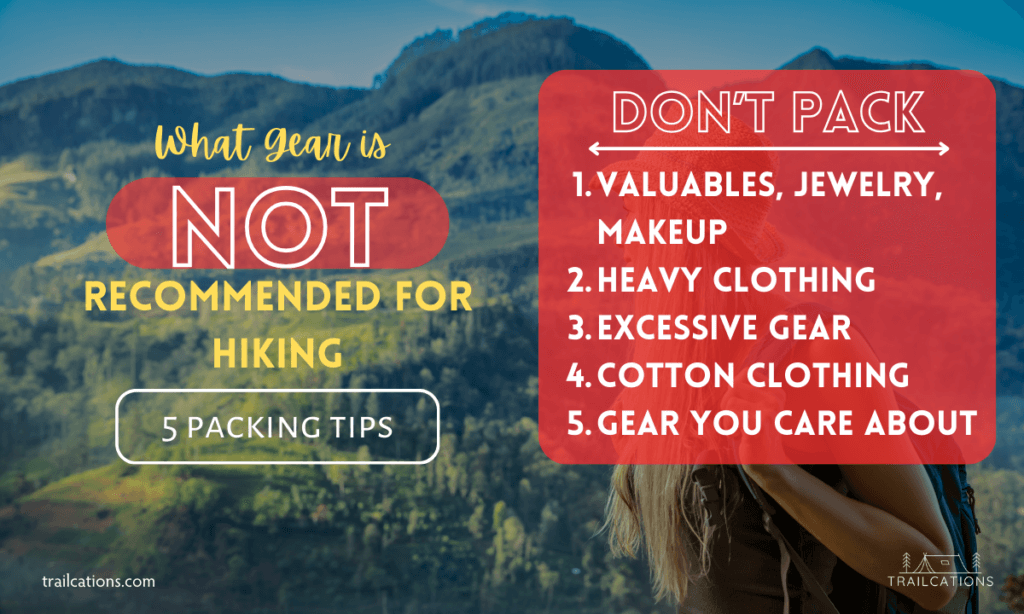
What Gear is Not Recommended for Hiking?
There are a few things that you should not take on a hike because it adds unnecessary weight to your pack or will make your hike more uncomfortable (or dangerous).
However, there’s a common hiker saying called, “Hike Your Own Hike” which basically means there’s no one size fits all when it comes to hiking. You do you.
So if wearing your grandma’s diamond earrings or trekking in pure white designer sneakers is important to you, hike your own hike my friend! Just keep in mind there’s a risk of your items getting lost, broken, dirty or eaten by a wild marmot. 😉
The gear that outdoor enthusiasts generally do not recommend for hiking includes:
1. Valuables, jewelry and makeup: These items are not essential for hiking and can become a burden if lost.
2. Heavy clothing: Hiking clothes should be lightweight and moisture-wicking. Avoid heavy, non-breathable fabrics that can impede movement and cause discomfort.
3. Excessive luxury items: Think long and hard about carrying that camping chair when a foam sit pad would do or a single camera lens instead of 3 or 4 lenses. Ounces = pounds and pounds = pain! Lightweight is the name of the game.
4. Cotton clothing: Cotton retains moisture, making it unsuitable for hiking as it can lead to discomfort and, in some cases, hypothermia. Opt for moisture-wicking materials like wool or synthetic fabrics instead.
5. Clothes, Gear and Shoes you care about: Hiking can be rough on clothing, gear and shoes, so it’s best to avoid wearing items that you are not willing to get dirty, sweaty, or potentially damaged.
Pro Tip: When parking at a trailhead, keep the interior of your car clean and hide your valuables to avoid break-ins. Don’t leave anything of value (or food) visible in your car when you leave to hike to deter thieves (and bears).
When preparing for a hike, it’s important to focus on essential and practical gear, considering the specific needs of the hike and avoiding items that are unnecessary or could weigh you down.
Frequently Asked Questions
What is the Best Backpack to Bring on a Day Hike?
When choosing a daypack for hiking, it’s important to consider factors such as comfort, weight, durability, adaptability, and user-friendliness.
Additionally, the capacity of the pack should align with your specific needs, whether it’s a short day hike or a longer, more demanding adventure.
Most day hikers will only need a 20-30 liter daypack but you may need more or less capacity depending on weather conditions, how lightweight your gear is and if you’re hiking with kids or pets.
What Should You Not Forget on a Hiking Trip?
When going on a hiking trip, there are several essential items that should not be forgotten. These include:
1. Navigation tools: Map, compass, GPS device, or a navigation app on your phone.
2. Illumination: Headlamp or flashlight with extra batteries.
3. Sun protection: Sunscreen, sunglasses, and a hat.
4. First-aid kit: Including essential medical supplies.
5. Multi-purpose tool or knife: For various tasks and emergencies.
6. Extra clothing: Sufficient layers to survive unexpected weather changes.
7. Food and water: Carry more than you think you’ll need, including an extra day’s worth.
8. Firestarter: Matches, lighter, or other fire-starting tools.
9. Emergency shelter: Such as a lightweight tent, emergency bivy, or space blanket.
10. Whistle: For signaling in case of an emergency.
It’s important to be prepared for the unexpected when hiking, and having these essential items can help ensure a safe and enjoyable outdoor experience.
What are the essential items to bring on a day hike?
When preparing for a day hike, it’s important to bring the right gear to ensure a safe and enjoyable trip. Some essential items to bring include a map, compass, sunscreen, insect repellent, headlamp or flashlight, and a multitool. You should also bring plenty of water and snacks, as well as a first aid kit.
What size backpack is recommended for a day hike?
The size of your backpack will depend on the length of your hike and the gear you need to bring. A 20-30 liter backpack, daypack or hydration pack is usually sufficient for a day hike. Other options for day hike backpacks if you have lightweight gear or are going for less than 2 hours are a sling bag, waist pack (fanny pack) or hydration pack. Make sure to choose a backpack with comfortable straps and a waist belt to distribute the weight of your gear.
What clothing should I wear for a day hike?
It’s important to dress appropriately for a day hike to stay comfortable and safe. Wear moisture-wicking clothing to keep sweat away from your skin, and dress in layers to adjust to changing temperatures. Choose sturdy, comfortable footwear with good traction, and wear a hat and sunglasses to protect your face and eyes from the sun.
What snacks should I pack for a day hike?
Pack snacks that are high in protein and carbohydrates to keep your energy levels up during your hike. Some good options include trail mix, energy bars, nuts, and fresh fruit. Don’t forget to bring enough water to stay hydrated throughout your hike.
What gear should I bring on a day hike?
In addition to the essential items mentioned earlier, you may also want to bring trekking poles to help with balance and reduce strain on your joints. Bathroom hygiene gear is important like toilet paper and soap and a trowel to dig a hole. A lightweight rain jacket and an extra layer of clothing can also be useful in case of changing weather conditions. If you plan on taking photos, bring a camera or smartphone with a protective case.
What should I include in my first aid kit for a day hike?
At minimum, your first aid kit should include items such as
- bandages
- gauze
- adhesive tape
- antiseptic wipes
- pain relievers
- personal medications (ex: inhaler, EpiPen, prescriptions)
Make sure to check your first aid kit regularly to ensure that all items are not expired and still in good condition.